BRIEF
Cultural History of India Introduction
Cultural History – Indian Art and Culture
“India is the cradle of human race, the birthplace of human speech, the mother of history, the grandmother of legend, and the great grandmother of tradition. Our most valuable and most astrictive materials in the history of man are treasured up in India only! “
Mark Twain
The roots of Indian art lies in the cultural heritage of Indian people and folk cults and Vedic thoughts as interpreted and reinterpreted in Vedic texts, Upanishads, Buddhists, and Jain and various other literatures.
Indian culture has been the product of two streams of thoughts and practices – one is classical, belonging to the sophisticated literary traditions. The other is the folk concept that belongs to the oral traditions operating at the folk levels in villages. The roots of the higher traditions lay in little traditions.
Our history says that sanctuaries of religious art and literature had sprung into existence in villages from earliest times, when religious teachers, poets, painters, musicians and epic performers sought recluse in the countryside. These sanctuaries made possible, survival of archaic myths and history and art rich and colourful. Historic development of professional village craftsmanship, like its content, tends towards Indian classical art.
The most interesting characteristic of Indian art is the variety of racial elements with different degrees of social development resulting in emergence of different cultures, customs and manners, coming from outside or developed within the country. Since about five hundred years, India possessed the rudiments of a more advanced social and political development. This early phase of development known as the Harappan culture named after the place where the first finds were made. A process of which in urban art, was to become even more marked and give birth to many specialized crafts. Indian plastic and pictorial arts of unimaginable antiquity evidenced a continuity that has survived very historical, social – economic and political development to produce an art that is especially Indian. These living traditions intrinsically linked with the historic cultural settings from which they arise and ultimately nurtured the local people. Despite this diversity India has always exhibited the great example of one in many. Folk is an uninterrupted tradition extending back more than twelve millennia.
Collectively it is called Indian cultural heritage.
Early History Of India

Palaeolithic
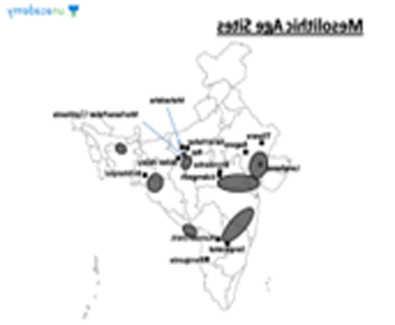
Mesolithic Period
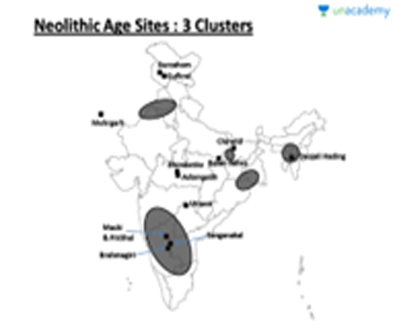
Neolithic Culture
500,000-200,000 BCE
Isolated remains of Homo erectus are found in Hathnora in the Narmada Valley in central India. It indicates that India might have been inhabited since at least the Middle Pleistocene era, somewhere between 500,000 and 200,000 years ago.
The earliest archaeological site in the subcontinent is the palaeolithic hominid site in the Soan River Valley.
1200-900 BCE
The Mesolithic period was followed by the Neolithic period. The first confirmed settlements appeared 9,000 years ago in the Bhimbetka rock shelters in Madhya Pradesh.
7000-500 BCE
Early Neolithic culture is represented by the Bhirrana findings (7500 BCE) in Haryana in India and Mehargarh (7000 BCE onwards) in Baluchstan in present Pakistan.
Neolithic agriculture cultures sprang up in the Indus Valley region around 5000 BCE.
Early History of India
500,000-200,000 BCE
Isolated remains of Homo erectus are found in Hathnora in the Narmada Valley in central India. It indicates that India might have been inhabited since at least the Middle Pleistocene era, somewhere between 500,000 and 200,000 years ago.
The earliest archaeological site in the subcontinent is the palaeolithic hominid site in the Soan River Valley.
1200-900 BCE
The Mesolithic period was followed by the Neolithic period. The first confirmed settlements appeared 9,000 years ago in the Bhimbetka rock shelters in Madhya Pradesh.
7000-500 BCE
Early Neolithic culture is represented by the Bhirrana findings (7500 BCE) in Haryana in India and Mehargarh (7000 BCE onwards) in Baluchstan in present Pakistan.
Neolithic agriculture cultures sprang up in the Indus Valley region around 5000 BCE.
Vedic Period
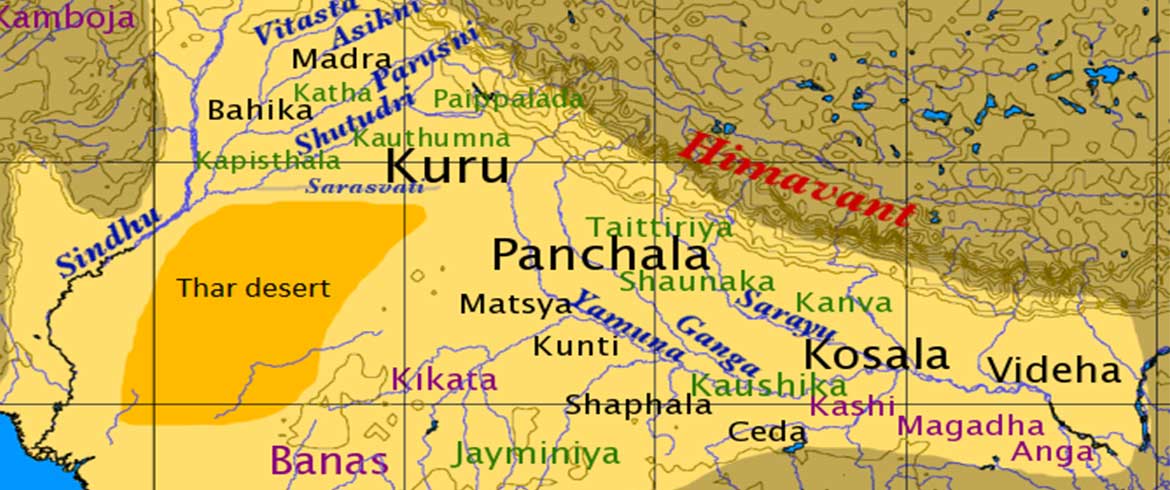
Vedic culture is the earliest culture in Indian history for which a fairly comprehensive record dating back to ancient times is available. The time span of the period is uncertain. Despite the difficulties in dating the period, Vedas can safely be assumed to be several thousands of years old. Scattered throughout the Rigveda are to be found various geographical, historical and social data throwing light on the life of the Vedic people in those ancient days.
Vedic culture, was centered early on in the northern and north-western parts of the Indian subcontinent, but has now spread and constitutes the basis of contemporary Indian culture.
Veda means knowledge through prayers. But prayers to whom and why? A close look at the context reveals that every thing that matters in the life of the people good or bad , was invoked , the benign for protection and well being and the malign to guard against any malefic influence. This sums up the very ethos of the ideology of nature worship. The term nature includes in its widest sense – sun, moon, stars, sky, earth, dawn, dusk, night, winds, rains, storm winds, cosmic energy, high seas, rivers, mountains, trees, forests, birds, and animals. Prayers are recited to ward off the goddess of death –nirrti, disease, hunger, starvation, malnutrition, and famines.
The ideas and beliefs developed in this period by seers are preserved in Vedas. These are regarded as expression of wisdom heard by seers in their quest for knowledge on Brahma, the ultimate reality and shristi, creation. When chanted, they enable the whole community to hear and share that wisdom. In a ceremony the proper uchcharan ie pronunciation of the Vedas is significant as it releases energy which invokes the Supreme Reality to descend and bless the occasion. Concepts contained in the Vedas developed over time in Upanishads, Brahmanas, Vedanta, Bhagwat Gita etc. Vedic religion was followed by Upanishads which gradually evolved into Vedanta, which is regarded by some as the primary institution of Hinduism. This led to the development of tantric metaphysics and gave rise to new forms of yoga, such as jnana yoga and bhakti yoga
The later part of this period corresponds with an increasing movement away from the previous tribal system towards the establishment of kingdoms, called Mahajanapadas.
Indus Valley Civilisation (3400-1700 BCE)
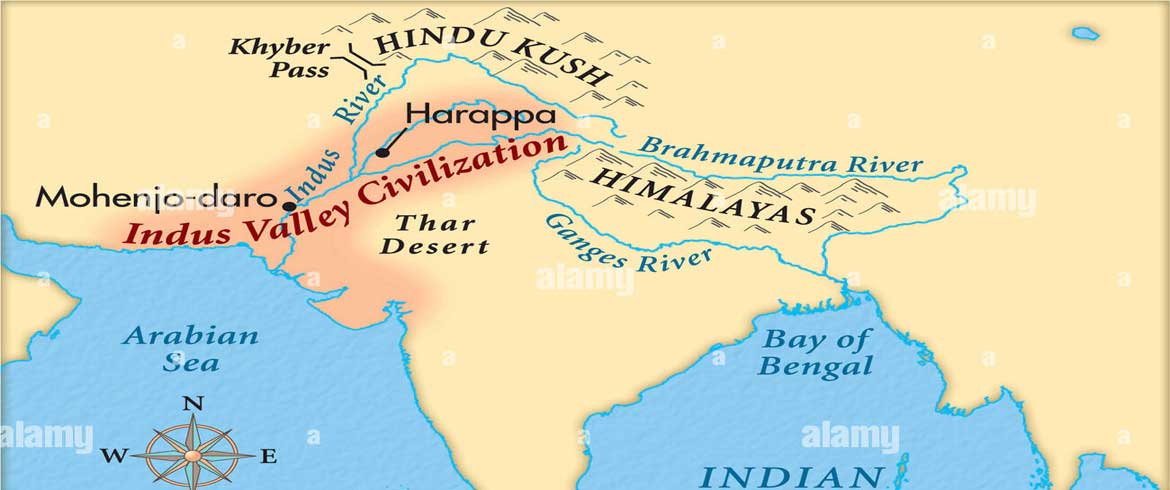
The Bronze Age in the Indian subcontinent began around 3400 BCE with the early Indus Valley Civilization.
Indus Valley Civilization was centrred on the river Indus and its tributaries. It is one of the world’s earliest urban civilizations contemporary to Mesopotamian and Egyptian civilisations. It was located in Gujarat, Haryana, Punjab and Rajasthan in India and in Sindh and Punjab in Pakistan and Baluchistan in modern-day. The famous cities are Dholavira, Kalibangan, Ropar, Rakhigrahi and Lothal in India and Harappa, Ganeriwala and Mohenjodaro in Pakistan. The Bronze Age in the Indian subcontinent began around 3400 BCE with the early Indus Valley Civilization. The three periods represent Indus Valley Civilisation:
Pre Harappan Culture 3400-2600 BCE
Mature Harappan Culture 2600- 1950 BCE
Post Harappan Culture 1950-1750 BCE
Late Vedic Age
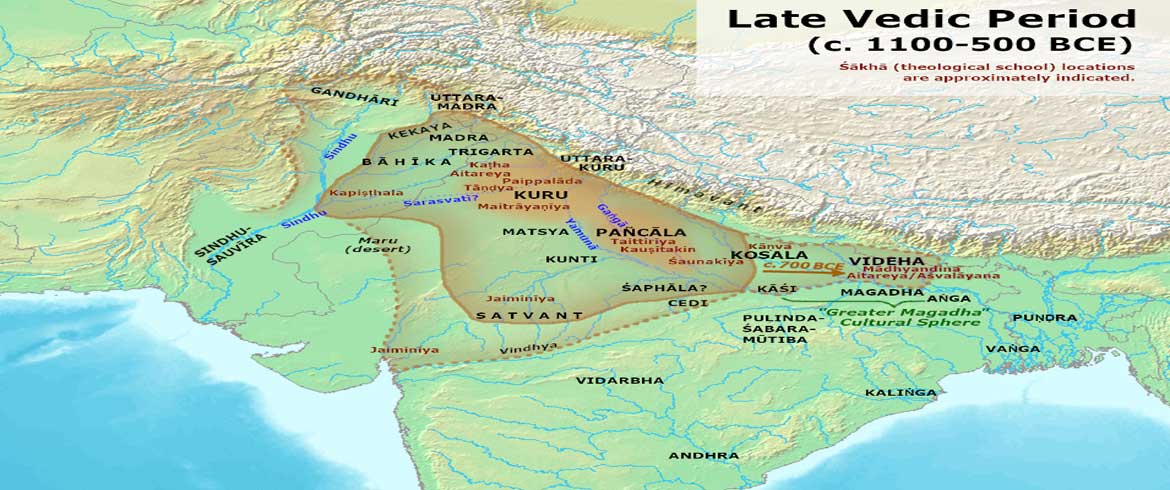
In the later Vedic Age, a number of small kingdoms or city states had covered the subcontinent, many mentioned in Vedic, early Buddhist and Jaina literature as far back as 1000 BCE. By 500 BCE, sixteen monarchies and “republics” known as the Mahajanpadas_Kasi, Kosala, Anga, Magadha,Vajji or Vrijji, Malla, Chedi, Vatsa or Vamsa, Kuru, Panchal, Matsya or Machcha, Surasena, Assaka, Ananti, Gandhara, and Komboja_ stretched across the Indo Gangetic plain from modern-day Afghanistan to Bengal and Maharastra. This period saw the second major rise of urbanism in India after the Indus Valley Civilisation.
Mahajanapadas were the sixteen most powerful kingdoms and republics of the era. Many of the sixteen kingdoms had coalesced to four major ones by 500/400 BCE, by the time of Gautam Buddha. These four were Vatsa, Avanti, Kosala, and Magadha. This period saw the second major rise of urbanism in India after the Indus Valley Culture.
No artistic remains have survived after the Indus culture. This is not to say, that there was no art in this period. The fact is, only perishable material was used such as wood and perhaps ivory. These got destroyed in hot and humid climate of India without any trace. But this period is important in the sense that there developed the Indian concept of the world and thought which was to find expression later in plastic arts of India.
Upanishaic Period (1000-300 BC)
The 9th and 8th centuries BCE witnessed the composition of the earliest Upanishads. Upanishads form the theoretical basis of classical Hinduism and are known as Vedanta.
In the later Vedic Age, a number of small kingdoms or city states had covered the subcontinent. Increasing urbanization of India in 7th and 6th centuries BCE led to the rise of new religious movements –Buddhism and Jainism which challenged the orthodoxy of rituals.
As early as 6th c. BC. India witnessed a remarkable religious resolution which profoundly influence the life and thought of the people. It was a positive reaction against rigid rituals based on Vedic religion. It was viewed from philosophical stand point with continuation with the metaphysical speculations of the Upanisads.
Buddhism arose in India during a period of intense intellectual and social ferment. It was a period during which the authority of the Vedas had been placed in doubt, the concept of god as a supreme being and creator was in question the hereditary restrictions on caste mobility were under attack, and the efficacy of Brahminical rituals was being challenged. The authors of the Upanishads had created the foundation for intense philosophical debate and encouraged the investigation of the real world based on reason and logic.
A great variety of sculpture in stone and metal, monastery and caves testify the greatness of Jainism , Buddhism and Hinduism. Common heritage can be perceived amidst the diverse styles at Ajanta and Ellora.
Influence of Persian and Greek
In 530 BCE Cyrus, King of the Persian Achaemenes Empire crossed the Hindu-Kush Mountains to seek tribute from the tribes of Kamboja, Gandhara and the trans-India region. By 520 BCE, during the reign of Darius I of Persia, much of the north western subcontinent (present-day eastern Afghanistan and Pakistan) came under the rule of the Persian Achaemenes Empire. The area remained under Persian control for two centuries. Under Persian rule the famous city of Takshashila became a centrr where both Vedic and Iranian learning were mingled. The impact of Persian ideas was felt in many areas of Indian life.
Persian ascendency in northern India ended with Alexander the Great’s conquest of Persia in 327 BCE. By 326 BCE, Alexander the Great had conquered Asia Minor and the Achaemenes Empire and had reached the northwest frontiers of the Indian subcontinent. He conquered much of the Punjab and confronted with the Nanda Empire of Magadha and the Gangaridai Empire of Bengal. After learning about the might of Nanda Empire, he was convinced that it was better to return.
The Persian and Greek invasions had left their impact on Indian civilization and culture. The region of Gandhara, or present-day eastern Afghanistan and northwest Pakistan, became a melting pot of Indian, Persian, Central Asian, and Greek cultures and gave rise to Greco-Buddhism, which lasted until the 5th century CE and influenced the artistic development of Mahayana Buddhism.
Early Middle Kingdoms (230 BC-700 AD)
Middle period was the period of cultural development in India.
Maurya Empire ruled by the Mauryan Dynasty from 322-185 BCE. It was a geographically extensive and mighty political and military empire in ancient India, established in the subcontinent by Chandragupta Maurya in Magadha (present day Bihar). The empire flourished under the reign of Ashoka the Great. Ashoka ruled the Maurya Empire for 37 years from 268 BCE until he died in 232 BCE. Ashoka’s reign propagated Buddhism. In this regard Ashoka established many Buddhist monuments.
Satvavahana Dynasty also known as the Andhras, ruled in southern and central India after around 230 BCE. They played an important role in the establishment of Buddhism in India and its spread to Central Asia and China. By the 3rd century, their empire in India was disintegrating; their last known great emperor being Vasudeva I (c. 190-225 CE).
Kharvela, the warrior king of Kalinga, who defeated sunga Empire ruled a vast empire and was responsible for the propagation of Jainism in the Indian subcontinent. The Kharavelan Jain Empire included a maritime empire with trading routes linking it to Burma, Thailand, Vietnam, Combodia, Borno, Bali, Sumatra, Sri Lanka and Java. Colonists from Kalinga settled in Sri Lanka, Burma, as well as the Maldives, Maritime Southeast Asia.
The north western hybrid cultures of the subcontinent included the Indo-Greeks, the Indo-Scythians, the Indo-Parthians, and the Indo-Sassanid. The first of these, the Indo-Greek Kingdom, founded when the Greco-Bactrian king Demetrius invaded the region in 180 BCE, extending his rule over various parts of present-day Afghanistan and Pakistan lasting for almost two centuries.
Late Classical Age

The Classical Age refers to the period when much of the Indian subcontinent was reunited under the Gupta Empire (c. 320–550 CE). This period has been called the Golden Age of India. The peace and prosperity created under leadership of Guptas enabled the pursuit of scientific and artistic endeavours in India. The high points of this cultural creativity are magnificent architecture, sculpture, and painting. The art of Ajanta caves is perhaps, the greatest art centre of the Gupta period Buddhist creative visual enterprises of India. It is well known for its creativeness and artistic excellence.
Different dynasties such as the Pandyas, Cholas, Cheras, Kadambas, Pallavas and Chalukyas, dominated the southern part of the Indian peninsula at different periods of time. Several southern kingdoms formed overseas empires that stretched into Southeast Asia. The kingdoms warred with each other and the Deccan states for domination of the south.
The Sassanid empire of Persia, who was contemporaneous with the Gupta Empire, expanded into the region of present-day Baluchistan in Pakistan, where the mingling of Indian culture and the culture of Iran gave birth to a hybrid culture under the Indo-Sassanids.
Indian history says that sanctuaries of religious art and literature had sprung into existence in villages from earliest times, when religious teachers, poets, painters, musicians and epic performers sought recluse in the countryside. These sanctuaries made possible, survival of archaic myths and history and folk art rich and colourful. Historic development of professional village craftsmanship, like its content, tends towards Indian classical art.
Because of changes or outside influences, new techniques and designs may be incorporated, but they are always adopted but never copied.
Classical Age (Gupta Period)
The “Late-Classical Age” in India began after the end of the Gupta Empire and after collapse of Harsha Empire in the 7th century C, and ended with the fall of the Vijainagara Empire in the south in the 13th century, due to pressure from Islamic invaders to the north.
From the 7th to the 9th century, three dynasties contested for control of northern India: the Gurjara, Pratiharas of Malva, the eastern Ganga dynasty of Odisha, the Palas of Bengal, and the Rashtiharas of the Deccan.
The first recorded Rajput kingdoms emerged in Rajasthanin the 6th century, and small Rajput dynasties later ruled much of northern India. One Gujar Rajput of the Chauhan clan, Prithvi Raj Chauhan was known for bloody conflicts against the advancing Islamic sultanates. The Shahi dynasty ruled portions of eastern Afghanistan, northern Pakistan, and Kashmir from the mid-7th century to the early 11th century.
The Chlukya Dynasty ruled parts of southern and central India from Badami in Karnataka between 550 and 750, and then again from Kalyani between 970 and 1190. The Pallavas of Kanchipuram were their contemporaries further to the south. With the decline of the Chalukya empire, their feudatories, the Hoysalas of Halibedu, Kakatiyas of Warangal, Seuna Yadavas of Dvagiri, and a southern branch of the Kalachuri, divided the vast Chalukya empire amongst themselves around the middle of 12th century.
The Chola Empire at its peak covered much of the Indian subcontinent conquered all of peninsular south India and parts of Sri Lanka. Rajendra Chloa I’s navies went even further, occupying coasts from Bur (Laccadive) islands, Sumatra, and the Malay Peninsula in Southeast Asia and the Pegu islands. Later during the middle period, the Panyan Empire emerged in Tamilnadu, as well as the Chera Kingdom in parts of Kerala and Tamilnadu. By 1343, last of these dynasties had ceased to exist, giving rise to the Vijainagara Empire.
The Hindu Vijainagara Empire came into conflict with the Islamic Bahamani sultanate, and the clashing of the two systems caused a mingling of the indigenous and foreign cultures that left lasting cultural influences on each other.
Bhakti Movement
In India, art and literature has kept alive the spirit of the people and their devotion to ancient myths, values and traditions even during the most powerful ravages and stresses of political changes over time. Ancient beliefs and traditions have had a continuous flow and when an outside element or influence came, this sturdy culture assimilated as much as it could to keep harmony with itself without losing its own basic character.
When Jaideva wrote Gita-Govinda in the 12th C. he broke away from the classical interpretation of love of Radha and Krishna. Radha was nayika who expressed her passion through different moods. Ragas were also associated with Radha. Hence, different ragas show different moods of Radha. The raga vasanta narrates the love play of Radha and Krishna, in raga bhairavi Radha rebukes Krishna for his faithlessness, the raga karnataka is tuned to the miseries of Radha. The Gita-Govida travelled to Kerala, Kangra, Assam, Orissa, Gujarat, Rajasthan, Uttar Pradesh and Bihar and, became the inspiration for the art of painting and other forms of art. In the 16th C. two religious saints Chaitanya (Bengal) and Vallabhacharya (Andhra) took up the Krishna legend and added to the erotic bhakti. In the same period a blind saint Surdas wrote poems on Radha and Krishna. The love stories of brij bhomi were rendered in narration, mime, song, dance and painted scrolls. The passionate retelling of Krishna’s legend made it live and contemporary. In the meantime the recitations and performances of Tulsidas’s Rama Charita Manasa created a new narrative visual art full of movement in the villages and cities of India. 16th c. was the age of great Bhakta cult of Vishnu and his incarnations. The paintings appeared on festive occasions on cloth, on paper, on pots and on clay walls of village huts.
The Islamic Sultanates
After conquering Persia, Muslim rulers were keen to invade India. Many short-lived Islamic kingdoms/sultanates under foreign rulers were established across the north western subcontinent over a period of a few centuries. This marked the introduction of a third Abrahamic Middle Eastern religion, following Judaism and Christianity, often in puritanical form. Later, the Brahmani Sultanate and Deccan sultanates, founded by Turkish rulers, flourished in the south.
The Vijainagar Empire rose to prominence by the end of the 13th century as a culmination of attempts by the southern powers to ward off Islamic invasions. The empire dominated all of Southern India and fought off invasions from the five established Deccan Sultanates. It lasted until 1646, though its power declined after a major military defeat in 1565 by the Deccan sultanates. As a result, much of the territory of the former Vijainagar Empire, were captured by Deccan Sultanates, and the remainder was divided into many states ruled by Hindu rulers.
In the 12th and 13th centuries, Turks and Afghans invaded parts of northern India and established the Delhi Sultanate in the former Rajput holdings. The subsequent Slave Dynasty of Delhi managed to conquer large areas of northern India, approximately equal in extent to the ancient Gupta Empire, while the Khilji dynasty conquered most of central India but were ultimately unsuccessful in conquering and uniting the subcontinent.
A Turk- Mongol conqueror in Central Asia, Timur (Tamerlane), attacked the reigning Sultan Nasir-u Din Mehmud of the Tughlaq Dynasty in the north Indian city of Delhi.
The Sultanate ushered in a period of Indian cultural renaissance. It is surmised that the language of Urdu was born during the Delhi Sultanate period as a result of the intermingling of the local speakers of Sanskritic Prakrits with immigrants speaking Persian, Turkish and Arabs under the Muslim rulers. The resulting “Indo-Muslim” fusion of cultures left lasting syncretic monuments in architecture, music, literature, religion, and clothing.
The Mughal Empire
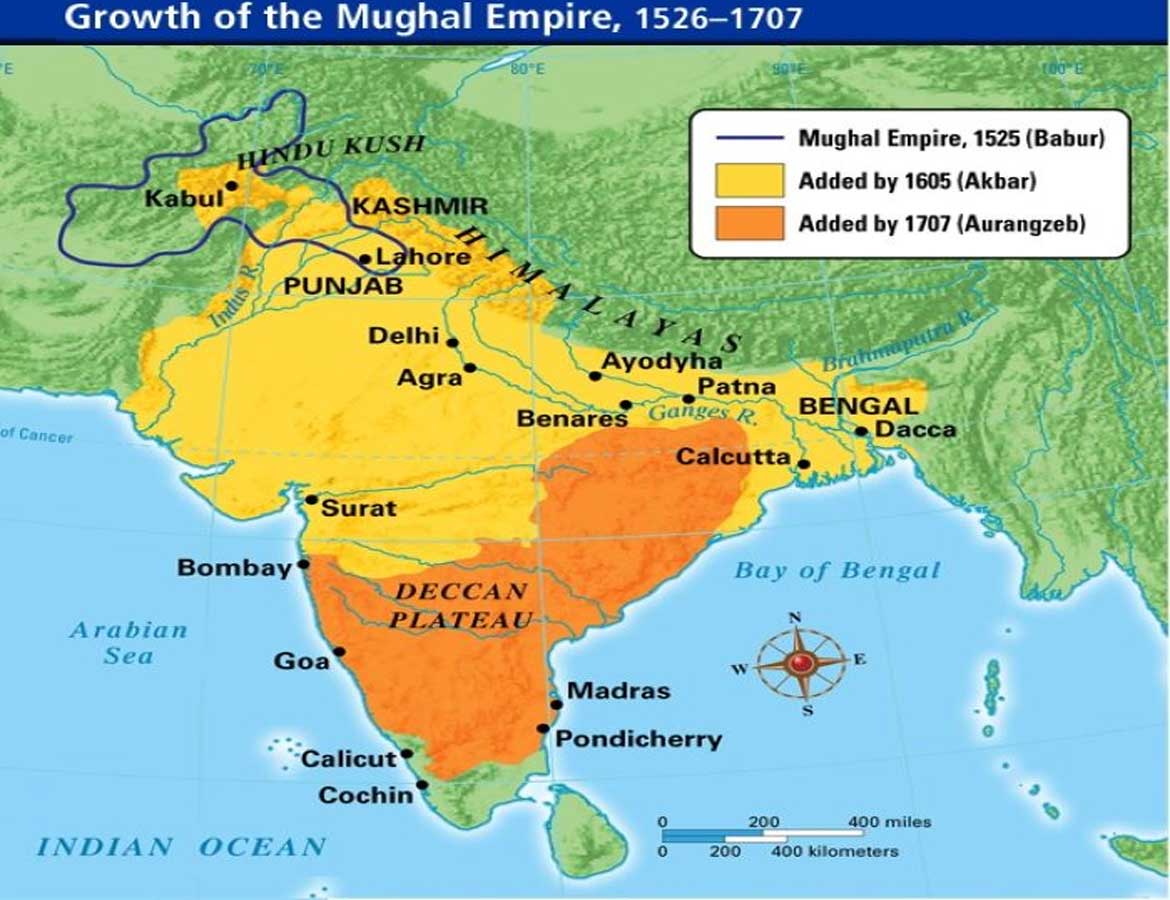
In 1526, Babur, a descendant of Timur and Chengis Kahn from Fergana Valley (present day Uzbekistan) swept across the Khyber Pass and established the Mughal Empire which covered modern day Afghanistan, Pakistan, India and Bangladesh. Babar ruled until 1530, and was succeeded by his son Humayun, but it is Humayun’s son, Akbar the Great, who is conventionally described as the ‘glory of the empire’. Akbar reigned from 1556 to 1605, and extended his empire as far to the west as Afghanistan, and as far south as the Godavari river. Akbar, though a Muslim, is remembered as a tolerant ruler, started a new faith, which was an attempt to blend Islam with Hinduism, Christianity, Jainism, and other faiths.
The courtly culture of the Mughals flourished under Jahangir’s rule. His son Shahjahan exhibiting a degree of centralized control rarely matched before. Shah Jahan left behind an extraordinarily rich architectural legacy, which includes the Taj Mahal and the old city of Delhi, Shahjahanabad. The later part of the seventeenth century the Mughal empire was beginning to disintegrate in the times of Aurangajeb. He tried to establish complete Muslim dominance, and as a result several historical temples were destroyed during this period.
The Mughal dynasty ruled most of the Indian subcontinent by 1600; it went in to a slow decline after 1707. The Mughals suffered severe blow due to invasions from Marathas and Afghans due to which the Mughal dynasty were reduced to puppet rulers by 1757 and was finally defeated during India’s first war of Independence in 1857.
Mughal period marked a vast social change in the subcontinent as the Hindu majority were ruled over by the Mughal emperors, most of the them showed religious tolerance, liberally patronizing Hindu culture. The famous emperor Akbar, the grandson of Babar, tried to establish a good relationship with the Hindus. They attempted to fuse their Turko-Persian culture with ancient Indian styles, creating a unique Indo-Saracenic architecture.
British Period (1600–1947)
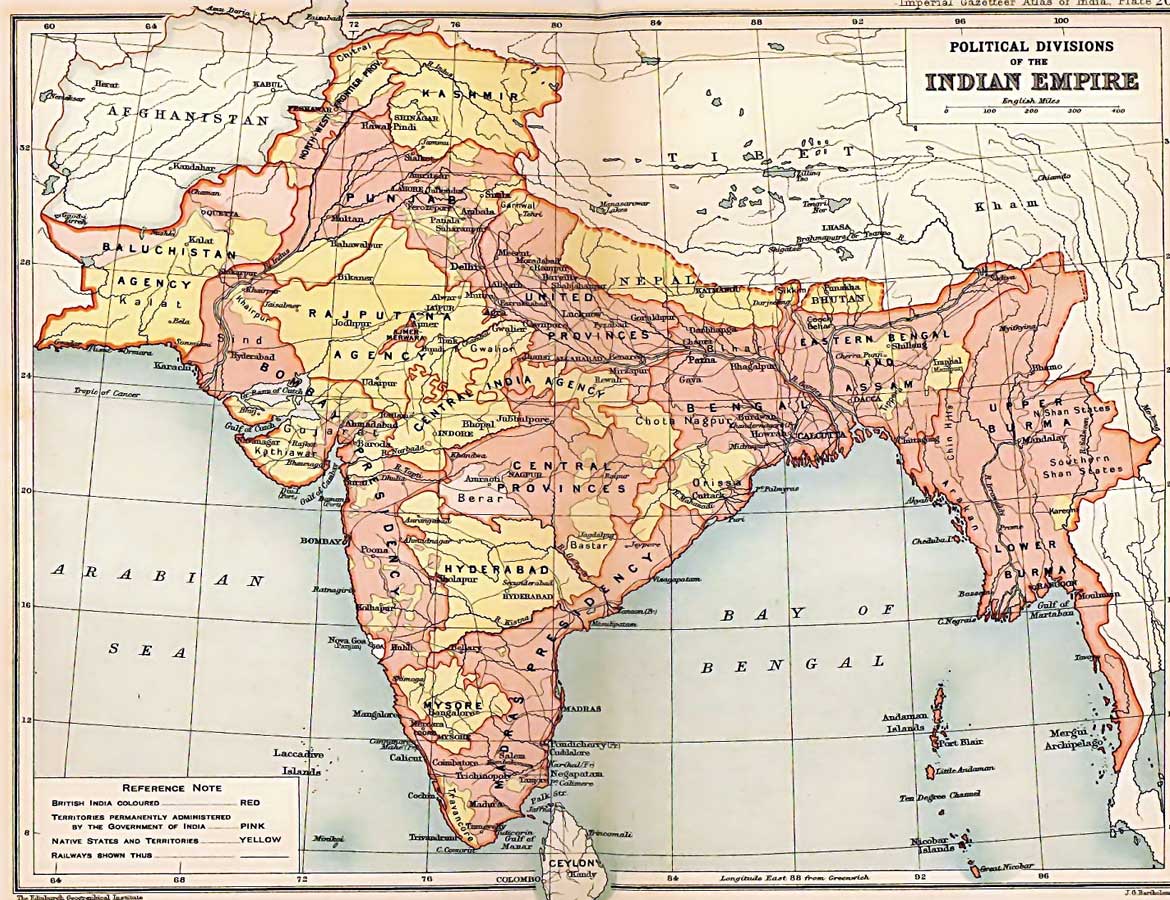
From the 16th century, European powers such as Portugal, Netherlands, France and the United Kingdom established trading posts in India. Later, they took advantage of internal conflicts and established colonies in the country. The British Rule in India began with the coming of the British East India Company in 1757 and continued till Indian independence from British rule in 1947.
British colonial rule had a great impact on Indian art. Old patrons of art became less wealthy and influential, and Western art more ubiquitous as the British Empire established schools of art in major cities. The Company style of paintings became common, created by Indian artists working for European patrons of the East India Company. The style was mainly Romanticized, with water colour the primary medium used to convey soft textures and tones. By1858, the British government took over the task of administration of India under the British Raj. The fusion of Indian traditions with European style at this time is evident from Raja Ravi Verma’s oil paintings of Indian women in a graceful manner.

